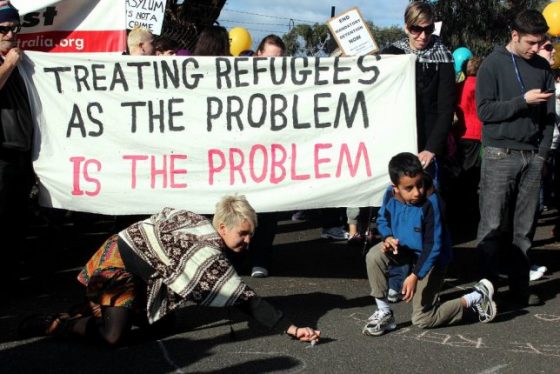By: James Simpson | Capital Research Center

The Gillard Government made a commitment in 2010 to release all children from immigration detention by June 2011, but still, 1000 children languish in the harsh environment of immigration camps around Australia. The Refugee Action Collective organized a protest on July 9, 2011, outside the Melbourne Immigration Transit accommodation which is used for the detention of unaccompanied minors.
Resettle with Caution (complete series)
National Security Concerns | State and Local Obstacles | Hidden Costs to Social Programs
[Editor’s Note: This is the second part of an in-depth investigation into America’s refugee resettlement program. You can read the first part here.]
Summary: A vast network of foundations, non-profits, government entities, and political organizations have a vested interest in the continued growth of the resettlement of refugees in America. Because they receive billions of dollars in federal grant money, publicly-financed, tax-exempt organizations have significant incentives to support political candidates and parties that will keep these programs alive. These organizations need to be thoroughly audited and the current network of public/private immigrant advocacy and resettlement organizations needs to be completely overhauled. Resettling refugees should be a voluntary, genuinely charitable activity, removing all the perverse incentives government funding creates.
The Red-Green Axis
One meaningful trade-off that the U.S. faces (and indeed, other countries grappling with the issue of rising refugee migration), is weighing national safety against potential terrorist activities. There is evidence that emigrating Muslims (which represent the fastest growing religious group in the world, according to Pew Research Center) strongly favor making Islamic (sharia) law the official law in their country. When this is debated in the U.S., Islamic apologists note that Muslims represent only 1 percent of the U.S. population. How could they be a threat to anyone?
Yet, in 2013, researcher Tim Murray noted that there is a “tipping point” when Muslim populations migrate to non-Muslim countries. This usually occurs when Muslim populations reach about 5 percent of the total, and the population begins to demand special privileges that go beyond customary religious accommodation, going so far as to insist upon enforcing sharia law within Muslim enclaves. At higher percentages, this civil disobedience turns to violence and terrorism.
The tipping point may be reached sooner in the U.S because American Muslim organizations like the Council on American Islamic Relations (CAIR) and other Muslim Brotherhood front groups have allied themselves with America’s radical Left in what has been called the Red-Green Axis—the “red” being the Left, and the “green” being the Islamists.[1] As such, Muslims enjoy the commanding heights of popular culture almost totally controlled by the Left, from Hollywood to universities, and all the way to the halls of Congress. They are not merely 1 percent of the population anymore. They can count on support from most Democrats, who comprise about 50 percent of the U.S. population, and whose Party is dominated by the hard Left.
The unholy alliance of Voluntary Agencies (VOLAGs), their affiliates, and self-interested politicians is a major component of this axis. The relentless effort to resettle refugees and other very needy groups from across the globe seeks to change the political, economic and cultural dynamic all over the U.S., especially in smaller communities that escape the public eye. The Obama administration’s dangerous support for all things Islamic saw unprecedented numbers of refugees and other immigrant classes from Muslim-majority nations coming to the United States.
Under Obama, most refugees were not carefully vetted for terrorism connections or criminal history. A. J. Irwin is a former special agent and ICE regional director who oversaw all joint terrorism task force investigations for the U.S. Central Region. In a public television forum, Irwin described the vetting process:
“[W]hen we send refugee officers over there to interview people, they have a mission and their mission is not to detect fraud or identify terrorists, it’s to process these people and get ’em into the system… They don’t spend a lot of time talking to them. They get their basic information; they see if they meet the basic requirements, do they have credible fear, what it’s based on, and then they move on to the next person. So, this process is very rapid, and the mission again is more service, it’s not enforcement, it’s not detection of fraud or national security.
According to documents obtained by Judicial Watch, the Obama administration knowingly and routinely allowed illegal aliens falsely claiming asylum to remain in the United States. A September 2016 DHS Inspector General report found that 1,982 aliens from countries known for immigration fraud or terror-links who were scheduled for deportation were instead granted citizenship using false identities because fingerprint records were missing.
We have already witnessed the deadly consequences of these policies, as terrorist attacks committed by refugees and those resettled under other special immigrant categories begin to mirror the out-of-control situation in Western Europe. As of March 2017, almost one-third of the 1,000 ongoing terrorist investigations in the U.S. involved people who entered the U.S. as refugees. As refugee numbers grow, however, national organizations like CAIR organize them, working hand-in-glove with American leftists to build power and subvert the rule of law while attacking anyone who associates Muslim immigration with terrorism as “Islamophobic”. This is the Red-Green Axis at work.
Further complicating matters, refugee groups utilize welfare at astronomical rates, despite having access to multiple special grants allegedly designed to help them achieve “self-sufficiency,” something that many never do. Other costs like crime, disease, language, and cultural barriers, add to the burdens local communities already face from years of slack economic activity. Finally, refugees are exempt from the Trump administration’s travel ban, even though many come from countries covered by the travel ban and reliable vetting is extremely difficult, if not impossible to conduct with certainty.
State & Local Refugee Resettlement Funding
Most state funding for resettlement is provided by HHS’s Office of Refugee Resettlement for State Administered programs, ($4.1 billion since 2008). The only spending states actually make is that needed to administer the state refugee office; the rest is pass-through money. The state does, however, face many ancillary costs. Refugee groups, along with unaccompanied alien children (UACs) increase amounts states must pay for their share of welfare and other programs. Education spending also soars at both state and local levels. Lewiston, Maine, for example, saw English Language Learners (ELL) budgets increase 4,000 percent from 2000. The number of ELL students increased from a few dozen to currently about one-quarter of the 5,000-member student body.
The State Administered program is one subset of overall Office of Refugee Resettlement program funding for refugees. There are seven others, including the Voluntary Agency program ($700.6 million since 2008), Discretionary Grants ($717.8 million since 2008), Targeted Assistance ($412.2 million since 2008), the Wilson-Fish program ($309.5 million since 2008), Services to Victims of a Severe Form of Trafficking ($80.1 million since 2008), Assistance to Torture Victims ($103.9 million since 2008) and the UAC program described earlier. In total, ORR provided $11.4 billion from 2008 to 2018. Note that this is substantially more than the $8.5 billion spent by the Office of Refugee Resettlement at the federal level. (See Issue 8 of Capital Research Magazine for more information on federal spending.) That $2.9 billion difference supports the many independent organizations that feed off the refugee program separate from VOLAGs and their affiliates.
Wilson Fish States
Currently, sixteen states and San Diego County, California, have quit the refugee resettlement program. This does not mean the program ends, however; it just means that the state now has lost whatever control over the program it ever had. A controversial alternative program appoints a VOLAG to take over management when the state drops out. Such states are referred to as Wilson-Fish states, based on a 1984 law named for the legislation’s congressional authors. The law called for alternative methods to provide welfare to refugees but never anticipated assigning VOLAGs oversight of state programs. The program was manufactured from whole cloth by HHS regulation during the Clinton administration. Recent state dropouts include Maine, Kansas, New Jersey, and Texas. These states dropped out in protest over the federal government’s unresponsiveness to terrorism concerns. However, this did not help the states.
When State Department, ORR, and U.S. Citizenship and Immigration Service monies are counted, VOLAGs are paid up to $5,000 or more for each refugee they resettle, so they seek to maximize refugee numbers and find it much easier to do so in states with no oversight. The numbers make the case. Between FY 2002 (the earliest state-by-state refugee resettlement data available) and FY 2018, Alabama, Alaska, Kansas, Kentucky, Maine, Nevada, New Jersey, North Dakota, Tennessee, and Texas dropped out. Of these, five have been run by VOLAGs long enough to compare resettlement data before the state left the program and after. Table V below shows the results. Note that even in just the first year, refugee resettlement in those states shot up an average of over 50 percent. In total, these states have seen an average annual increase of 127 percent in refugee numbers since they relinquished program oversight.
In the next installment of Resettle with Caution, learn about the state and local difficulties associated with indiscriminate refugee resettlement.
















